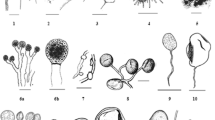Abstract
The closely related fern generaHemionitis L. andGymnopteris Bernhardi are separated primarily on differences in leaf architecture and venation. Studies indicate that these characters are highly variable and unreliably diagnostic. Further, the type species of the two genera readily hybridize with each other. Spore morphology, as exhibited by SEM, does not support the traditional alignment of the species in these two genera: some species ofHemionitis andGymnopteris have the same rugose to papillate spores, while other species from both genera possess crested spores. The flavonoid chemistry of these taxa coincides with spore type, i.e., taxa from both genera which possess crested spores produce kaempferol and quercetin 3-0-glycosides, while species with tuberculate spores produce only quercetin 3,4′-0-glycosides. The spore and chemical data suggest a realignment of these taxa within a single genus, which would avoid the rather tenuous dependence on a single vegetative character for generic distinctions.
Similar content being viewed by others
Literature Cited
Berti, G. & F. Bottari. 1968. Constituents of ferns. Pp. 590–685.In: L. Reinhold & Y. Livschitz (Editors). Progress in phytochemistry, Vol. 1. Interscience. London.
Bierhorst, D. W. 1977. The systematic position ofPsilotum andTmesipteris. Brittonia 29: 3–13.
Cooper-Driver, G. 1977. Chemical evidence for separating the Psilotaceae from the Filicales. Science 198: 1260–1262.
Copeland, E. B. 1947. Genera Filicum. Ronald Press. Waltham, Massachusetts. Giannasi, D. E. 1974. Phytochemical aspects of fern systematics. Ann. Missouri Bot. Gard. 61: 368–378.
—. 1975. The flavonoid systematics of the genusDahlia (Compositae). Mem. New York Bot. Gard. 26: 1–25.
Harborne, J. B. 1973. Flavonoids. Pp. 344–380.In: L. P. Miller (Editor). Phytochemistry, Vol. 2. Van Nostrand. New York.
—. 1975. The biochemical systematics of flavonoids. Pp. 1056–1095.In: J. B. Harborne, T. J. Mabry & H. Mabry (Editors). The flavonoids. Chapman and Hall. London.
—. 1977. Flavonoids and the evolution of the angiosperms. Biochem. Syst. & Ecol. 5: 7–22.
— & C. A. Williams. 1975. Flavone and flavonol glycosides. Pp. 376–441.In: J. B. Harborne, T. J. Mabry & H. Mabry (Editors). The flavonoids. Chapman and Hall. London.
Haufler, C. H. 1977. A biosystematic study of the fern genusBommeria. Ph.D. Thesis, Indiana University, Bloomington, Indiana.
Lellinger, D. B. 1965. A quantitative study of generic delimitation in the adiantoid ferns. Ph.D. Thesis, University of Michigan, Ann Arbor, Michigan.
Mabry, T. J., K. R. Markham & M. B. Thomas. 1970. The systematic identification of flavonoids. Springer-Verlag. New York.
Mickel, J. T. 1974. A redefinition of the genusHemionitis. Amer. Fern J. 64: 3–12.
Niklas, K. J. & D. E. Giannasi. 1977. Flavonoids and other chemical constituents of fossil MioceneZelkova (Ulmaceae). Science 196: 877–878.
Pridham, J. B. 1956. Determination of sugars on paper chromatograms with P-anisidine hydrochloride. Anal. Chem. 28: 1967–1968.
Scora, R. W. & W. H. Wagner, Jr. 1964. A preliminary Chromatographic study of eastern AmericanDryopteris. Amer. Fern J. 54: 105–113.
Smith, D. M. & D. A. Levin. 1963. A Chromatographic study of reticulate evolution in the AppalachianAsplenium complex. Amer. J. Bot. 50: 952–958.
Swain, T. 1975. Evolution of flavonoid compounds. Pp. 1096–1129.In: J. B. Harborne, T. J. Mabry & H. Mabry (Editors). The flavonoids. Chapman and Hall. London.
— & G. Cooper-Driver. 1973. Biochemical systematics in the Filicopsida. Pp. 111–134.In: A. C. Jermy, J. A. Crabbe & B. A. Thomas (Editors). The phylogeny and classification of the Ferns. Academic Press. London and New York.
Underwood, L. M. 1902. American Ferns. IV. The genusGymnogramme of the Synopsis Filcum. Bull. Torrey Bot. Club 29: 617–634.
Wallace, J. W. & K. R. Markham. 1978. Apigenin and amentoflavone glycosides in the Psilotaceae and their phylogenetic significance. Phytochemistry 17: 1313–1317.
Wollenweber, E. 1978. The distribution and chemical constituents of the farinose exudates in gymnogrammoid ferns. Amer. Fern J. 68: 13–28.
Author information
Authors and Affiliations
Additional information
An erratum to this article is available at http://dx.doi.org/10.2307/2806006.
Rights and permissions
About this article
Cite this article
Giannasi, D.E., Mickel, J.T. Systematic implications of flavonoid pigments in the fern genus hemionitis (adiantiaceae). Brittonia 31, 405–412 (1979). https://doi.org/10.2307/2806135
Issue Date:
DOI: https://doi.org/10.2307/2806135




